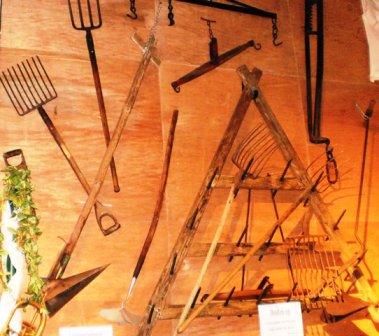I suspect that a wooden harrow is nowadays mostly known as a rustic decoration on facades of restaurants, a triangular frame with cross bars, and placed like bowling pins in a game, wooden pens. A harrow is pulled over the plowed land to break clods, crumble ground to make it plane and equal. Actually a large rake, to make soil fine and even so that the base layer and the plant roots do not dry out. Many hand harrows are rectangular in shape. A triangle can usually be managed easily behind a horse, and holds better a straight direction.
To get a good result it will be necessary to weigh this harrow by poles, stones or concrete tied on.
 You get a great harrow if you use a mat of steel rebar. They have mesh in various sizes. Optionally, you may at some even rows cut the wires and fold them down as teeth. And on odd-numbered rows the odd wires. But it’s not necessary. Just a concrete post lashing on it, and it works.
You get a great harrow if you use a mat of steel rebar. They have mesh in various sizes. Optionally, you may at some even rows cut the wires and fold them down as teeth. And on odd-numbered rows the odd wires. But it’s not necessary. Just a concrete post lashing on it, and it works.
There are different harrow for tractors with spring-tooth and crumble rollers. But for man- or horsepower it is all too heavy.
You can also use a lump breaker to draw parallel seed furrows. And also to shut them again after sowing. Or to weed, e.g. between corn. (Of course, with a narrow harrow that remains between the rows.)
By harrowing broadcasted grain seeds they will lay in rows and grow more profitable.
A trail for the finer work consisted of a panel of woven branches. A ride trail consisted of a pile on which brushwood bundles were tied. They were also used for weeding wasteland, spreading dung on pasture and covering seeds.
The transport of implements to the field was usually done on a sled behind the horse, not a (higher) carriage.
